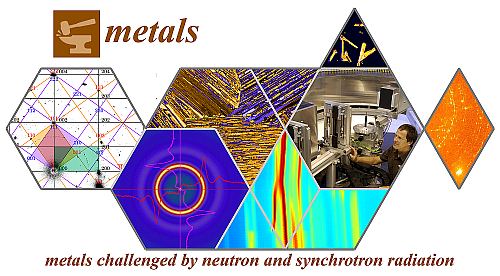Metals Challenged by Neutron and Synchrotron Radiation
A special issue of Metals (ISSN 2075-4701).
Deadline for manuscript submissions: closed (30 November 2015) | Viewed by 138800
Special Issue Editor
Interests: X-ray free electron; in-situ investigations; extreme conditions
Special Issues, Collections and Topics in MDPI journals
Special Issue Information
In the past decade, neutron and synchrotron radiation techniques have come to the forefront as an excellent set of tools for the investigation of materials structure and properties. This holds true, especially for metals. The goal of this Special Issue is to compile a broad range of state-of-the-art contributions in this field into a single collection. Gathering reviews of diffraction and scattering methods, data reconstruction and combined modeling, as well as applications on particular metallic systems, such as titanium aluminides, magnesium, steels, nuclear metals, etc., is of interest. This Special Issue also seeks detailed and accurate case-studies on individual systems. Research fields of interest will range from engineering, through materials design to fundamental materials science. I wish to suggest non-exclusively, strain scanning, texture analysis, phase transformation, precipitation, microstructure reconstruction, crystal defects, atomic structures (both crystalline and amorphous), order and disorder, kinetics, time resolved microstructure evolution, local structure correlations, phonons, deformation and transformation mechanisms, response to extreme conditions, local and integrated studies, in bulk and at interfaces. Techniques will be mainly based on neutrons and synchrotron X-rays, and may be complemented by other quantum beams, such as electron diffraction, muon spectroscopy, and microscopic techniques. Advanced techniques include high-energy X-ray diffraction, microbeam techniques, X-ray microscope, materials oscilloscope, coherent beam scattering, three-dimensional X-ray diffraction, texture analysis, in-situ studies, time resolved, pump-probe techniques, neutron and X-ray spectroscopy, quantitative phase analysis, peak profile analysis, to mention but a few.
Prof. Dr. Klaus-Dieter Liss
Guest Editor

Manuscript Submission Information
Manuscripts should be submitted online at www.mdpi.com by registering and logging in to this website. Once you are registered, click here to go to the submission form. Manuscripts can be submitted until the deadline. All submissions that pass pre-check are peer-reviewed. Accepted papers will be published continuously in the journal (as soon as accepted) and will be listed together on the special issue website. Research articles, review articles as well as short communications are invited. For planned papers, a title and short abstract (about 100 words) can be sent to the Editorial Office for announcement on this website.
Submitted manuscripts should not have been published previously, nor be under consideration for publication elsewhere (except conference proceedings papers). All manuscripts are thoroughly refereed through a single-blind peer-review process. A guide for authors and other relevant information for submission of manuscripts is available on the Instructions for Authors page. Metals is an international peer-reviewed open access monthly journal published by MDPI.
Please visit the Instructions for Authors page before submitting a manuscript. The Article Processing Charge (APC) for publication in this open access journal is 2600 CHF (Swiss Francs). Submitted papers should be well formatted and use good English. Authors may use MDPI's English editing service prior to publication or during author revisions.
Keywords
- diffraction; imaging; spectroscopy
- poly-crystalline; single-crystalline; amorphous
- structural changes; kinetics; time-resolved
- phase transformations; microstructures; plasticity; mechanisms
- strain; stress; texture
- reciprocal space; real space; coherent beams
- phonons; vibrations; ultrashort times
- high energy synchrotron X-rays; neutron reactor; spallation source; free-electron laser
- light metals; steels; intermetallics; special metals
- extreme conditions; high temperature; uni-axial load; impact; high-pressure
Benefits of Publishing in a Special Issue
- Ease of navigation: Grouping papers by topic helps scholars navigate broad scope journals more efficiently.
- Greater discoverability: Special Issues support the reach and impact of scientific research. Articles in Special Issues are more discoverable and cited more frequently.
- Expansion of research network: Special Issues facilitate connections among authors, fostering scientific collaborations.
- External promotion: Articles in Special Issues are often promoted through the journal's social media, increasing their visibility.
- e-Book format: Special Issues with more than 10 articles can be published as dedicated e-books, ensuring wide and rapid dissemination.
Further information on MDPI's Special Issue polices can be found here.






